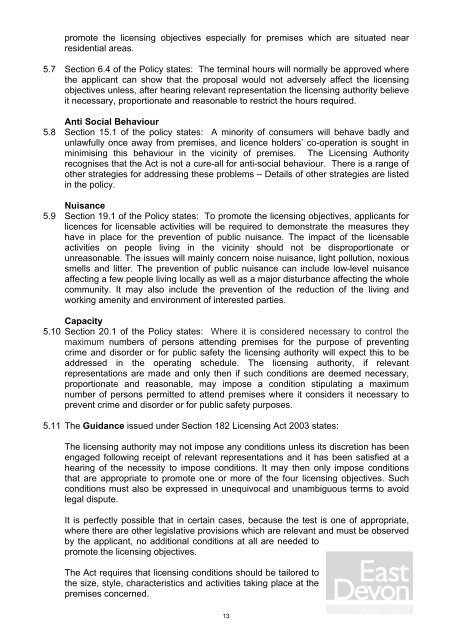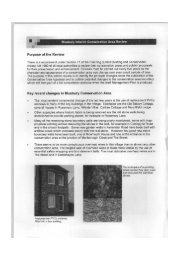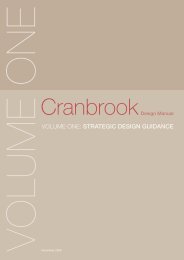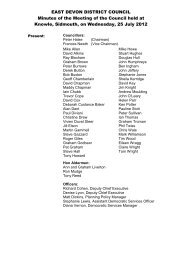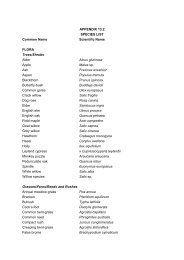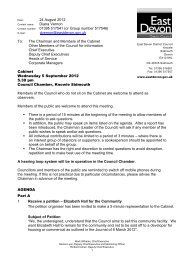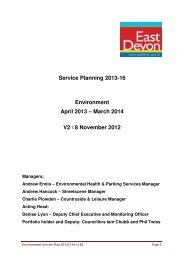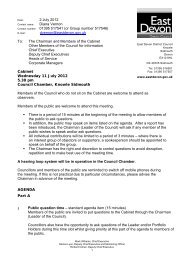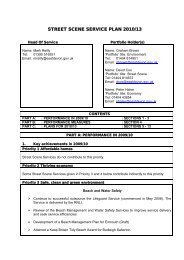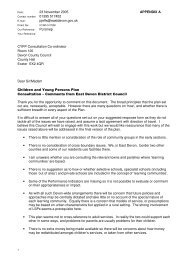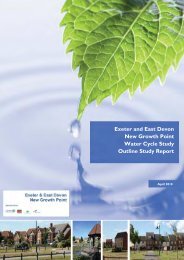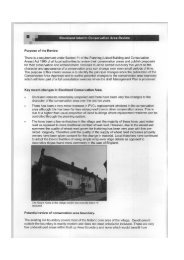10 December 2013 - East Devon District Council
10 December 2013 - East Devon District Council
10 December 2013 - East Devon District Council
Create successful ePaper yourself
Turn your PDF publications into a flip-book with our unique Google optimized e-Paper software.
promote the licensing objectives especially for premises which are situated near<br />
residential areas.<br />
5.7 Section 6.4 of the Policy states: The terminal hours will normally be approved where<br />
the applicant can show that the proposal would not adversely affect the licensing<br />
objectives unless, after hearing relevant representation the licensing authority believe<br />
it necessary, proportionate and reasonable to restrict the hours required.<br />
Anti Social Behaviour<br />
5.8 Section 15.1 of the policy states: A minority of consumers will behave badly and<br />
unlawfully once away from premises, and licence holders’ co-operation is sought in<br />
minimising this behaviour in the vicinity of premises. The Licensing Authority<br />
recognises that the Act is not a cure-all for anti-social behaviour. There is a range of<br />
other strategies for addressing these problems – Details of other strategies are listed<br />
in the policy.<br />
Nuisance<br />
5.9 Section 19.1 of the Policy states: To promote the licensing objectives, applicants for<br />
licences for licensable activities will be required to demonstrate the measures they<br />
have in place for the prevention of public nuisance. The impact of the licensable<br />
activities on people living in the vicinity should not be disproportionate or<br />
unreasonable. The issues will mainly concern noise nuisance, light pollution, noxious<br />
smells and litter. The prevention of public nuisance can include low-level nuisance<br />
affecting a few people living locally as well as a major disturbance affecting the whole<br />
community. It may also include the prevention of the reduction of the living and<br />
working amenity and environment of interested parties.<br />
Capacity<br />
5.<strong>10</strong> Section 20.1 of the Policy states: Where it is considered necessary to control the<br />
maximum numbers of persons attending premises for the purpose of preventing<br />
crime and disorder or for public safety the licensing authority will expect this to be<br />
addressed in the operating schedule. The licensing authority, if relevant<br />
representations are made and only then if such conditions are deemed necessary,<br />
proportionate and reasonable, may impose a condition stipulating a maximum<br />
number of persons permitted to attend premises where it considers it necessary to<br />
prevent crime and disorder or for public safety purposes.<br />
5.11 The Guidance issued under Section 182 Licensing Act 2003 states:<br />
The licensing authority may not impose any conditions unless its discretion has been<br />
engaged following receipt of relevant representations and it has been satisfied at a<br />
hearing of the necessity to impose conditions. It may then only impose conditions<br />
that are appropriate to promote one or more of the four licensing objectives. Such<br />
conditions must also be expressed in unequivocal and unambiguous terms to avoid<br />
legal dispute.<br />
It is perfectly possible that in certain cases, because the test is one of appropriate,<br />
where there are other legislative provisions which are relevant and must be observed<br />
by the applicant, no additional conditions at all are needed to<br />
promote the licensing objectives.<br />
The Act requires that licensing conditions should be tailored to<br />
the size, style, characteristics and activities taking place at the<br />
premises concerned.<br />
13


